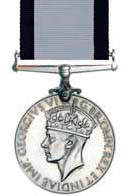Conspicuous Gallantry Medal (CGM)

Awarded to men of non-commissioned rank of the British Armed Forces, for conspicuous gallantry in operations against the enemy.
First established
By Queen Victoria, 7 July 1874 (discontinued in 1993).
WW1 recipient
CPO Arthur Robert Blore, Anson Bn, RND, gazetted 13 September 1915
For services at Gallipoli:
‘The battalion having occupied a portion of the enemy's fire trench on the 4th June, was engaged in digging communication trenches to a position in rear of it, on which they were consolidating the line. The officer being shot, Seaman Blore took charge of a party of 22, who advanced to cover the retirement. He shot two of the crew of a Turkish machine-gun enfilading the trench, and kept up a steady fire checking the enemy who were re-occupying it. He exhibited great bravery and power of leadership on a difficult occasion.’ (Gazette supplement 29292)
First bar, 29 October 1918:
‘… he went forward alone, and, single-handed, rushed the crew of a heavy machine gun, shooting the gunners. The enemy position was then turned, and thereby captured. By his initiative and personal courage a strong position was taken and many casualties avoided’ (Gazette supplement 30979)
Blore entered Collingwood Battalion, Royal Naval Division, at the beginning of WW1. He married Edith Mary Fraser in 1918 at Great Missenden, Buckinghamshire. Blore was the only man to be awarded a bar to the CGM. He died in 1947.
